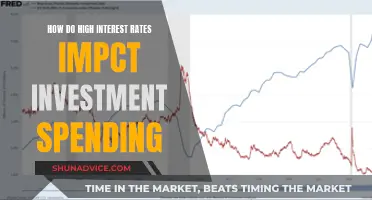
If you have $1 million to invest, there are several options available to you, depending on how much risk you're willing to take. You could put your money into a high-yield savings account, which would earn you a guaranteed interest rate of around 4-5%. If you want to live off the interest, you'll need to spend less than $5,000 per month. Alternatively, you could invest in assets that offer the potential for higher returns, such as stocks, bonds, real estate, or private credit. These options come with more risk and volatility but could generate higher monthly income. Another option is to buy Treasury bills, which pay monthly dividends and have lower minimum investments.
| Characteristics | Values |
|---|---|
| Interest rate | 4-5% |
| High-yield savings account interest rate | 4.35% |
| Amount of interest per year on $1,000,000 in a high-yield savings account | $43,500 |
| Amount of interest per month on $1,000,000 in a high-yield savings account | $3,625 |
| Types of investments | Private credit, stocks, real estate, corporate bonds, Treasury bonds, Treasury bills, Treasury bill ETFs, REITs |

High-yield savings accounts
It's important to note that most investments are currently paying between 4-5% interest. So, if you want to live off the interest from your portfolio, you'll need to spend less than $5,000 per month, and depending on where you live and after accounting for taxes, this number may be closer to $4,000 per month. If you need a higher monthly income, you may need to consider investing in assets that generate higher returns, such as those mentioned above.
When choosing a high-yield savings account, it's important to compare interest rates and fees across different financial institutions to find the best option for your needs. Additionally, it's worth considering the level of risk you are comfortable with and diversifying your investments to minimise risk.
Budget Surplus Impact: Interest Rates and Investments
You may want to see also

Bonds
If you're looking to invest $1 million and want to generate monthly interest, one option to consider is bonds. Bonds are a type of interest-bearing asset that can provide a stable and reliable source of income.
There are different types of bonds available, each with its own level of risk and potential return. For example, corporate bonds tend to be riskier than Treasury bonds because there is a higher chance of a company defaulting on its debt compared to the US government.
When investing in bonds, it's important to diversify your portfolio to manage risk effectively. This means investing in a variety of bonds from different issuers and industries. By doing so, you can reduce the impact of any single bond defaulting on your overall investment.
It's important to note that while bonds are generally considered a stable investment option, they do carry some level of risk. This includes the risk of default, where the issuer of the bond is unable to make interest payments or repay the principal amount. Additionally, bond prices can be affected by changes in interest rates and market conditions, which can impact the value of your investment.
Overall, investing in bonds can be a viable option for generating monthly interest from your $1 million investment. By carefully considering the different types of bonds available and diversifying your portfolio, you can potentially earn a steady income while managing risk effectively.
Maximizing Investment Returns: Understanding Interest Calculations
You may want to see also

Real estate
If you're looking to invest $1 million to generate monthly interest, one option is to invest in real estate.
One way to do this is to buy properties and rent them out to tenants. To maximise your return on investment, choose properties in growing areas where the value is likely to increase over time. Before investing, research and check local trends to ensure the area is a good fit.
Another option is to invest in real estate investment trusts (REITs). These are publicly traded companies that own or finance real estate. You can purchase shares in REITs through a broker or financial advisor. However, it's important to note that while REITs are more liquid, they can be sensitive to interest rate changes.
Investing in real estate can provide a stable income stream through rental payments or dividends. However, it's important to consider the additional risks and volatility associated with this type of investment.
Compounding Interest: Investment Products to Earn More
You may want to see also

Private credit
If you want to live off the interest from your portfolio, you'll need to spend less than $5,000 per month. This number can be closer to $4,000 per month after accounting for taxes. If you need more than that in annual income, you may need to invest in assets that generate even higher income, like bonds, real estate, and private credit.
You can also buy Treasury bills in a regular brokerage account (such as Public or Fidelity) or directly from the government on TreasuryDirect.gov. Treasury bills are interest-bearing assets that are typically stable investments that pay interest on a set schedule.
Investments and Interest: Multiple Bets, Better Returns?
You may want to see also

Treasury bills
For those with $1 million to invest, Treasury bills can provide a steady stream of income with relatively low risk. The interest earned on Treasury bills can help supplement other sources of income or be used to fund retirement.
When considering investing in Treasury bills, it is important to remember that while they are considered a stable investment, there is still some risk involved. It is always advisable to consult with a financial advisor to determine if Treasury bills are a suitable investment for your specific financial goals and risk tolerance.
Foreign Investments: Interest Rates and Their Intricate Relationship
You may want to see also
Frequently asked questions
Most investments are currently paying between 4-5% interest. This means you can expect to earn between $40,000 and $50,000 per year, or between $3,333 and $4,166 per month.
Interest-bearing assets include savings accounts, Treasury bills, bonds, and other bank products.
While some interest-bearing assets are stable and reliable, others come with more risk, volatility, and uncertainty. For example, a corporate bond is riskier than a Treasury bond because a company is more likely to default than the U.S. government.







